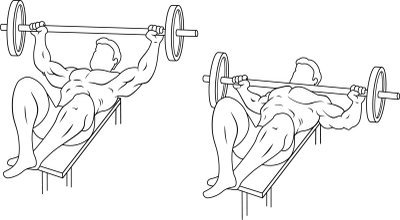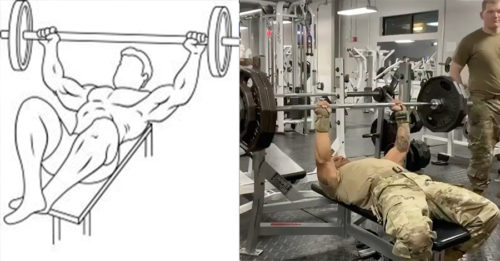The flat bench press seems to produce results with beginners, and it’s always nice to see your numbers go up, but in terms of building a complete breastplate, moving a flat bar from a flat bench in a flat range of motion leaves a lot to be desired.
The traditional bench press (and in fact most traditional compound chest exercises) is lacking because it places too much biomechanical importance on either shoulders or triceps, and not enough on the chest.
On the other side of the coin, you have isolation movements: cable flys, pec-decks, and all the other stuff you see in the bodybuilding magazines. I won’t say they don’t work (quite the opposite in fact), and for advanced trainees, they’re fairly essential to polish your physique.
So, we have the most basic of compound movements, which are great for beginners, and basic isolation movements, which are great for advanced lifters…how about everyone in between?
For most people, too much bench pressing and not enough “other” stuff has led to some decent development of the lower and outer parts of your chest (the upper chest and inner boobs), but not much else.
The following three exercises are meant to address just that.
There’s one to focus on the upper chest, one for the inner, and then one for the chest as a whole while taking your shoulders and triceps out of it.
Gironda Neck Press – Grow Some Upper Boobies
Also known as a “Guillotine Press,” the neck press is an exercise developed by the late, great Vince Gironda, who took specified training to a new level.
If you’re looking for a way to add some mass to your upper chest (and you should be, because it’s bad ass), this is the way to go.
While it looks a bit like a traditional barbell bench press, but instead of bringing the bar to your chest, you bring it down to your throat. (It’s not hard to see the origin of either moniker).
Doing so increases activation of the upper pec significantly. How significantly?
Well, in a recent EMG test done by my buddy Bret Contreras for his Tmuscle article series, the guillotine press actually had the second highest peak contraction for upper pec of all exercises tested. In addition, it ranked HIGHEST for peak contraction for both mid pec and lower pec.
So while the neck press is one of the best for upper pec (which is notoriously hard to hit), it’s also great for chest overall.
Still not convinced? Bret’s study also demonstrated that a guillotine press with 225 pounds actually recruited MORE pec than a traditional bench press loaded with 275 pounds.
Basically, it’s the single best barbell chest exercise you can be doing, from the perspective of recruitment.
Of course, I have to make the obligatory safety statement and mention that this one can be a little tough on the shoulder if you’re not flexible. Start (and stay) light–form and recruitment are BY FAR more important than weight here.
NOTE: You can also do this with a mild incline.

Squeeze Press – Too Many Inappropriate Jokes to Pick Just One
This is an incredible dumbbell exercise that I am blatantly stealing from Coach Thibs over at TMuscle. (He stole the idea of posing shirtless for pictures from me, so I don’t feel bad about this.)
Anyway, the squeeze press DB bench press movement with one slight difference: the dumbbells are kept in contact with each other at all times and you’re actively squeezing them inward (against each other) as hard as possible.
This simple action will shift all the stress onto the pectorals. Keep in mind of one the main biomechanical functions of the pectorals is to adduct the humerus; that is, to bring it medially across the body, or towards the midline.
While that happens to some degree during nearly any pressing exercise for the chest, resistance is eliminated once you cross the halfway point of the exercise, and so activation of the pecs from an adduction perspective dies down.
With the squeeze press, we eliminate that limitation.
By actively squeezing the dumbbells together, you are engaging the pectorals throughout the entire range of motion, forcing the muscles to fire in an attempt to facilitate adduction. Tricky, tricky.
NOTE: It’s very important to understand this point: you should squeeze in the dumbbells as hard as possible during every inch of every single rep. This is what makes this exercise effective.
Fly Away – Change it Up
The fly away is a chest exercise that falls under the classification of “compound-isolation movements” that can be very effective if used correctly.
Before we can talk about the exercise specifically, we need to go over what that means.
One part oxymoron, two parts kick-ass training method, a Compound-Isolation Movement is an exercise that begins as a compound, multi-joint movement and then — right smack dab in the middle — switches to an iso to hit a desired body part; the transition occurs in the pause between the eccentric and concentric portions of the whole movement.
It’s not really all that complicated once you’re thinking about it. It all has to do with mechanics.
The first factor to consider is the number of muscles involved.Unless you have some very bizarre strength imbalance, you’ll be able to use much more weight for a compound movement than you could for an isolation movement, assuming that both lifts use the same primary mover.
Another factor that we must take into account is eccentric or negative strength. It’s been shown that, generally, eccentric strength is roughly 50-75% greater than concentric strength in most trainees.
Compound-isolations come as a result of the two above factors.
We know that you’re stronger in a compound movement than an isolation movement.
Because of the mechanical advantages inherent to each part of the lift, you’ll hopefully be able to use a weight that is significantly challenging in both the positive and negative phases of the exercise.
The Fly-Away is an exercise that crosses a dumbbell press and fly. You begin the movement by pressing the weight up, just as you would during a normal dumbbell bench press. Once you reach the top, pause for a second, and lower the weight with the eccentric motion of a dumbbell fly.
As with any chest exercise, remember to focus on flexing the pecs throughout the entire movement. Once again, here I am showing the exercise.
NOTE: I change my grip mid-way through the video to show that you can do these with either a parallel/neutral grip or a pronated grip. You don’t need to change during a single set.
If you love the bench press, you may also defend it. Still sucks, though.



Post your comment